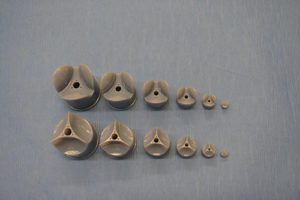
In rotary jet spinning technology, a rotating nozzle extrudes a solution of extracellular matrix (ECM) into nanofibers that wrap themselves around heart valve-shaped mandrels. By using a series of mandrels with different sizes, the manufacturing process becomes fully scalable and is able to provide JetValves for all age groups and heart sizes. [Image from Wyss Institute at Harvard University]
A research team led by Kevin Kit Parker created a valve-shaped nanofiber network that replicates the mechanical and chemical properties of the native valve extracellular matrix (ECM). They used the Parker lab’s proprietary rotary jet spinning technology that was essentially a rotating nozzle that thrust an ECM solution into the nanofibers. The nanofibers then wrapped themselves around any heart valve–shaped mandrels.
“Our setup is like a very fast cotton candy machine that can spin a range of synthetic and naturally occurring materials,” said Parker in a press release. “In this study, we used a combination of synthetic polymers and ECM proteins to fabricate biocompatible JetValves that are hemodynamically competent upon implantation and support cell migration and repopulation in vitro. Importantly, we can make human-sized JetValves in minutes – much faster than possible for other regenerative prostheses.”
The JetValve method is similar to another method known as electrospinning.
“You take a polymer and put it into a controlled ionic field and you sputter this through a nozzle and it forms a long fiber and orients on the far side in a random orientation and it creates a fiber-like mesh,” Stan Rowe, Corporate Vice President of Advanced Technology and Chief Scientific Officer at Edwards Lifesciences, said.
The team tested JetValves in collaboration with at team at the University of Zurich in Switzerland, a partner institute of the Wyss Institute, led by Simon P. Hoerstrup. Hoerstrup and his team recently developed regenerative, tissue-engineered heart valves that were designed to replace mechanical and fixed-tissue heart valves. He used human cells that directly deposited a regenerative layer of complex ECM on biodegradable scaffolds shaped as heart valves and vessel. The living cells were eliminated from scaffolds and what was left was an off-the-shelf human matrix-based prostheses that was ready to be implanted.
“That’s kind of taking electrospinning one step further,” Rowe said. “It’s a pretty cool technology, but it’s pretty far from being commercial-ready. It’s exciting nonetheless. I think they’ve shown some early feasibility that’s encouraging, but remember that a lot of people want their heart valve to last a long time, like their lifetime.”
Normal heart valves can take anywhere from six to 12 hours to assemble, according to Rowe. Additionally, the valves that the Harvard research team developed were pulmonary valves. Aortic valves are usually what is replaces in heart valves replacement procedures.
“The pressures and the requirements of the aortic valve are substantially higher and more demanding than the pulmonic valve,” Rowe explained.
The current method for making heart valves involves creating a biomaterial through a process that has been perfected over the years.
“[To create a heart valve], you take a biological substance and process it into a biomaterial to remove proteins and cross link it to form an implantable material. That process has been around for 30 years and has been refined over 30 years to produce a really strong, biocompatible material that people trust,” Rowe said.
The Harvard team implanted JetValves into sheep using a minimally-invasive procedure and were able to show that the valves could function properly in circulation and could regenerate new tissue.
“In our previous studies, the cell-derived ECM-coated scaffolds could recruit cells from the receiving animal’s heart and support cell proliferation, matrix remodeling, tissue regeneration and even animal growth,” said Hoerstrup. “While these valves are safe and effective, their manufacturing remains complex and expensive as human cells must be cultured for a long time under heavily regulated conditions. The JetValve’s much faster manufacturing process can be a game-changer in this respect. If we can replicate these results in humans, this technology could have invaluable benefits in minimizing the number of pediatric re-operations.”
The Wyss Institute for Biologically Inspired Engineering and the University of Zurich recently announced that they are also collaborating to create a functional heart valve replacement with the capacity to repair, regenerate and grow. They also intend to create a GMP-grade version of the manufacturing process that is already customizable, scalable and cost-effective and enable a high number of prostheses to be created.
“Achieving the goal of minimally invasive, low-cost regenerating heart valves could have tremendous impact on patients’ lives across age-, social- and geographical boundaries,” said Donald Ingber, Wyss Institute founding director. “Once again, our collaborative team structure that combines unique and leading expertise in bioengineering, regenerative medicine, surgical innovation and business development across the Wyss Institute and our partner institutions, makes it possible for us to advance technology development in ways not possible in a conventional academic laboratory.”
The study was published online in the journal Biomaterials.
[Want to stay more on top of MDO content? Subscribe to our weekly e-newsletter.]





Dear sir/madam:
Has the new method of JetValve been tested on human? What were the results?
If yes, which institutes/hospitals accept patients for such heart valve regenerating surgeries?
Thanks.
This is definitely a question to ask the researchers directly.